Politics and Government
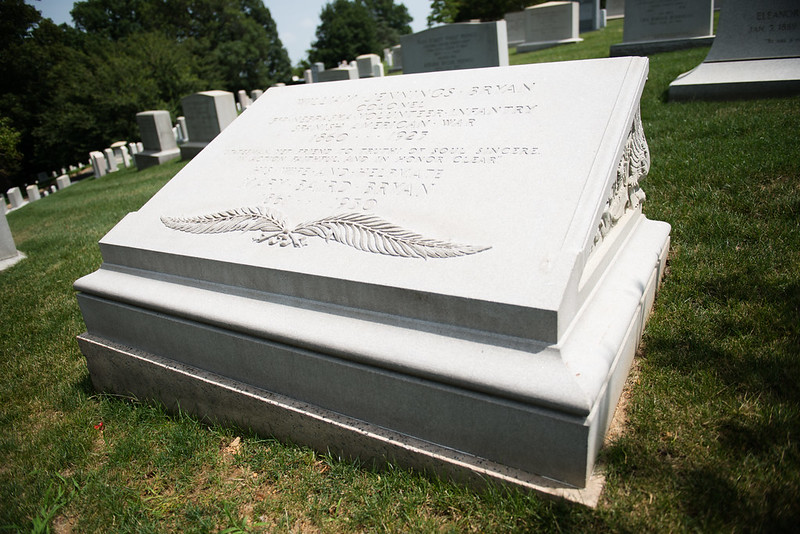
Congress
William Jennings Bryan (1860-1925) — Bryan represented Nebraska in the House of Representatives from 1891 to 1895, and ran for president on the Democratic ticket three times: in 1896, 1900 and 1908. The populist politician was best known for his "Cross of Gold" speech, in which he advocated the coinage of silver as a solution to the economic crises of the 1890s. During the Spanish-American War (1898), he helped organize the Third Nebraska Volunteer Infantry Regiment, despite having no prior military experience. He also served as secretary of state under President Woodrow Wilson, from 1912 to 1915. Late in life, Bryan earned fame for his role in the "Scopes Monkey Trial" of July 1925, in which he helped prosecute a Tennessee schoolteacher accused of teaching Charles Darwin's theory of evolution instead of the Biblical doctrine of divine creation. Bryan died in his sleep six days after the trial concluded. The inscription on his gravestone reads, "Statesman, yet friend to truth! Of soul sincere, in action faithful, and in honor clear." (Section 4, Grave 3121)
Edward M. Kennedy, U.S. Army (1932-2009) — Senator Edward "Ted" Kennedy, President John F. Kennedy's youngest sibling, was the third-longest-serving member of the Senate in U.S. history, representing Massachusetts for 43 years. After dying from brain cancer on Aug. 25, 2009, he was interred in Section 45, just to the south of his brother Robert F. Kennedy. His grave is marked by a white wooden cross and a marble footstone. Sen. Kennedy was eligible for burial at Arlington National Cemetery because of his service in the U.S. Army from 1951 to 1953. (Section 45, Grave S-45-B)
Robert F. Kennedy, U.S. Navy (1925-1968) — President John F. Kennedy's younger brother, Robert F. Kennedy, was a World War II U.S. Navy veteran who served as United States attorney general (1961-1964), a senator from New York (1965-1968) and a 1968 Democratic presidential candidate. He was assassinated in Los Angeles on June 5, 1968, shortly after winning the California Democratic primary. Kennedy was eligible for burial at Arlington National Cemetery on the basis of his Navy service. Read more about Robert F. Kennedy's gravesite and funeral. (Section 45, Grave S-45-A)
Theodore Fulton “Ted” Stevens, U.S. Army (1923–2010) — Ted Stevens, a decorated World War II veteran, served as a Republican senator from Alaska for 40 years (1968-2009). After joining the Army Air Corps, he flew as a pilot with the “Flying Tigers” of the 14th Air Force, who transported supplies over the perilous Himalayan “hump” in the China-Burma-India theater. A graduate of Harvard Law School, Stevens began working for the Interior Department in 1956 and played a key role in Alaska becoming a state (1959). Appointed to the Senate to fill a vacancy in 1968, he subsequently won election and re-election six times. As a senator, Stevens brought massive corporate and federal funding to Alaska, including for construction of the Trans-Alaska Pipeline. To his supporters, Stevens was a fierce champion of Alaskan economic growth; to his critics, his name was synonymous with pork-barrel politics and corruption. On July 29, 2008, a federal grand jury indicted him for failing to properly disclose gifts from an Alaska-based energy company. A judge later dismissed the conviction (due to prosecutorial misconduct), but the highly-publicized trial cost Stevens his re-election bid, effectively ending his political career. On August 9, 2010, Stevens died in the crash of a small airplane in Alaska. The Stevens Joint Mobility Complex at Alaska’s Eielson Air Force Base is named after him, as is the Anchorage International Airport. (Section 30, Grave 281-LH)
John Wingate Weeks, U.S. Navy (1860-1926) — John Wingate Weeks served in both houses of Congress and as secretary of war under two presidents. An 1881 graduate of the United States Naval Academy, he served in the Massachusetts Naval Brigade (1890-1900) and as a volunteer in the U.S. Navy during the Spanish-American War (1898). Though Weeks initially worked in civil engineering, he made his fortune in banking, as co-founder of the Boston financial firm Hornblower and Weeks. A committed Republican, in 1904 he was elected to the House of Representatives, representing Massachusetts for four terms; he subsequently won election to the Senate, where he served one term (1913-1919). In 1921, President Warren Harding appointed Weeks secretary of war, a position that he continued under President Calvin Coolidge. (Section 5, Grave 7064)
Secretaries of State
William Jennings Bryan (1860-1925) — Culminating a long career in government, William Jennings Bryan served as secretary of state under President Woodrow Wilson, from 1912 to 1915. He had previously represented Nebraska in the House of Representatives from 1891 to 1895, and had run for president on the Democratic ticket three times: in 1896, 1900 and 1980. Considered a populist, Bryan was best known for his "Cross of Gold" speech, in which he advocated the coinage of silver as a solution to the economic crises of the 1890s. During the Spanish-American War (1898), he helped organize the Third Nebraska Volunteer Infantry Regiment, despite having no prior military experience. Late in life, Bryan also earned fame for his role in the "Scopes Monkey Trial" of July 1925, in which he helped prosecute a Tennessee schoolteacher accused of teaching Charles Darwin's theory of evolution instead of the Biblical doctrine of divine creation. Bryan died in his sleep six days after the trial concluded. The inscription on his gravestone reads, "Statesman, yet friend to truth! Of soul sincere, in action faithful, and in honor clear." (Section 4, Grave 3121)
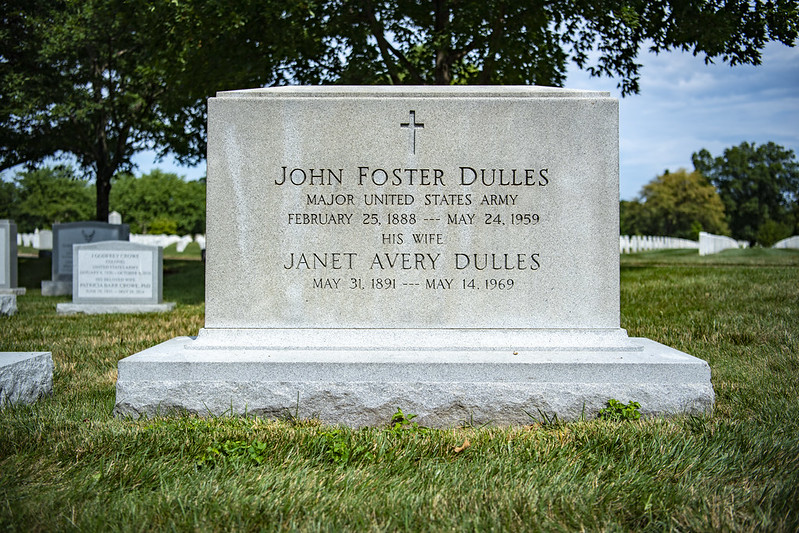
John Foster Dulles, U.S. Army (1888-1959) — One of the most influential statesmen in American history, Secretary of State John Foster Dulles played a key role in shaping U.S. foreign policy during the Cold War. Born to a prominent Washington, D.C. family, Dulles graduated from Princeton University and the George Washington University Law School, with a focus on international law. During World War I, Dulles' poor eyesight prevented him from joining the Army, but he received an Army commission as a major on the War Industries Board. President Woodrow Wilson then appointed him as legal counsel to the U.S. delegation at the 1919 Paris Peace Conference. In various capacities, Dulles continued advising U.S. foreign policy during the 1920s through 1940s, helping to craft the United States' role in the newly created United Nations and its response to the emergence of fascism and communism. Dulles was a staunch anti-communist, due in part to his Presbyterian faith; as President Dwight D. Eisenhower's secretary of state (1953-1959), he pursued foreign policies that went beyond merely containing Soviet expansion to attempting to "roll back" Moscow's global power and influence. (Section 21, Grave 31)
James V. Forrestal, U.S. Navy (1892-1949) — The United States' first secretary of defense and a Navy veteran of World War I, Forrestal served in that position from 1947 to 1949 — following the National Security Act of 1947, which unified the U.S. armed forces under the newly-created Department of Defense. In addition to guiding the military through this bureaucratic reorganization, Forrestal helped to formulate early Cold War defense policy. The former investment banker had proven himself to be a skilled military administrator during World War II. As undersecretary and then secretary of the Navy, he organized the Navy's massive wartime expansion and procurement programs. The inscription on his headstone reads: "In the great cause of good government." (Section 30, Grave 674)
Walter Q. Gresham, U.S. Army (1832-1895) — Walter Q. Gresham served as President Grover Cleveland's secretary of state from March 7, 1893 to May 28, 1895. Following his service in the U.S. Army during the Civil War and promotion to the rank of brevet brigadier general, President Ulysses S. Grant appointed him as U.S. district judge for Indiana. Later, during President Chester A. Arthur’s administration, Gresham served first as postmaster general and then as secretary of the treasury for the remainder of Arthur’s term. Gresham ran as a presidential candidate in the Republican Party primaries in 1884 and 1888, before accepting the secretary of state position in President Cleveland’s administration. His tenure ended upon his unexpected death in 1895. (Section 2, Grave S-11)
Alexander M. Haig Jr., U.S. Army (1924-2010) — Alexander M. Haig served as President Ronald Reagan's first secretary of state, as chief of staff under Presidents Richard Nixon and Gerald Ford, and as President Nixon's deputy national security advisor. One of Nixon's most influential advisors, Haig has been described as a kind of "acting president" who held the White House together during the final months of Watergate. He ultimately played a key role in persuading Nixon to resign. In addition to these civilian leadership positions, Haig had a distinguished military career: a decorated veteran of the Korean War and the Vietnam War, he served as supreme allied commander of NATO forces from 1974 to 1979, and retired from active Army service in 1979 as a four-star general. (Section 30, Grave 418-LH)
George C. Marshall, U.S. Army (1880-1959) — One of the most distinguished military, diplomatic and political leaders of the 20th century, General George C. Marshall served as chief of staff of the U.S. Army during World War II (1939-1945). He directed the largest expansion of the Army in U.S. history, from fewer than 200,000 men before the war to more than eight million, with an unmatched arsenal of modern weapons and equipment. He also played a key role in shaping American military strategy, advocating an invasion of Nazi-occupied France via the English Channel. On December 16, 1944, Marshall was promoted to General of the Army (five stars), the nation's highest rank. After the war, President Harry Truman appointed him secretary of state (1947-1949) and secretary of defense (1950-1951); he is the only person to have held both positions. Marshall's diplomatic career was as historically significant as his military one. Most notably, he conceived an ambitious, highly successful program for the postwar economic recovery of Western Europe — known as the "Marshall Plan" — for which he received the Nobel Peace Prize in 1953. (Section 7, Grave 8198)
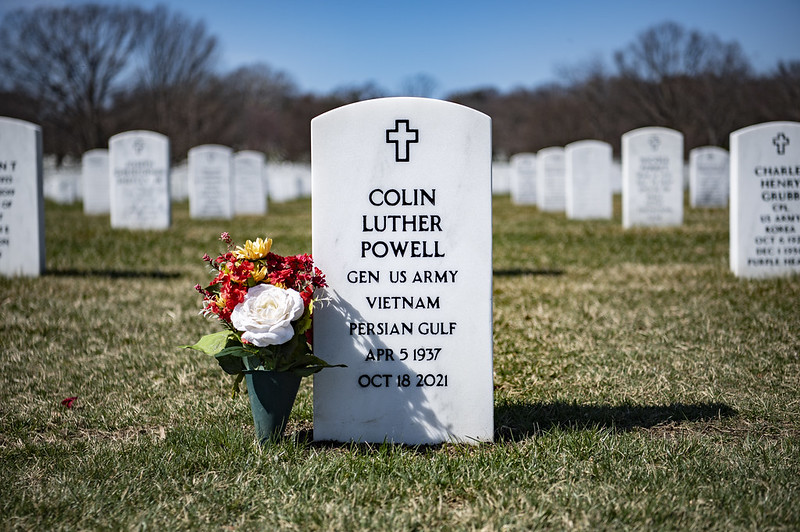
Colin L. Powell, U.S. Army (1937–2021) — Vietnam veteran Gen. Colin Powell was the first African American to hold three of the U.S. government’s highest positions: national security advisor (1987-1989), chairman of the Joint Chiefs of Staff (1989-1993) and secretary of state (2001-2005). The son of Jamaican immigrants, Powell grew up in the South Bronx and enrolled in Army ROTC during college; he was commissioned as a second lieutenant in 1958. By 1989, he had risen to the rank of four-star general. His many awards and decorations include two Presidential Medals of Freedom and the Congressional Gold Medal. (Section 60, Grave 11917)
William P. Rogers, U.S. Navy (1913-2001) — A Navy veteran of World War II, William P. Rogers served as attorney general from 1957 to 1961, under President Dwight D. Eisenhower, and as secretary of state from 1969 to 1973, under President Richard M. Nixon. Rogers often clashed with Nixon and was overshadowed by Henry Kissinger, the national security advisor; however, his distance from Nixon allowed him to survive the Watergate scandal unscathed. In 1986, Rogers returned to public service as the chair of a presidential commission charged with investigating the explosion of the Challenger space shuttle. (Section 30, Grave 817)
Other Cabinet Positions
Ronald H. Brown, U.S. Army (1941-1996) — Brown had a distinguished career in law and public service. After graduating from Middlebury College and St. Johns University School of Law, Brown served in the U.S. Army for four years, with postings in South Korea and Europe, attaining the rank of captain. He then practiced law at the prestigious Washington firm of Patton, Boggs and Blow, advised the presidential campaigns of Senator Edward Kennedy and Jesse Jackson, and served as chairman of the Democratic National Committee (1989-1992). In 1993, President Bill Clinton appointed him as secretary of commerce. On April 3, 1996, Brown and 34 other people were killed aboard a U.S. Air Force CT-43 that crashed in Croatia. (Section 6, Grave 8389-B)
Oscar L. Chapman, U.S. Navy (1896-1978) — Oscar Chapman served in the Navy during World War I. His 20 years of service with the U.S. Interior Department culminated with his appointment as secretary of the interior in 1949. Throughout his career, Chapman advocated for civil rights and strongly President Truman's decision to desegregate the armed forces. (Section 11, Grave 775-2)
Robert Todd Lincoln, U.S. Army (1843-1926) — The first son of President Abraham Lincoln and Mary Todd Lincoln, and their only son to live to adulthood, Robert Todd Lincoln was a Harvard-educated lawyer, statesman and business executive. During the Civil War, he was commissioned as a U.S. Army captain and served as assistant adjutant to General Ulysses S. Grant. He then returned to civilian life, building a successful Chicago law practice. While he declined suggestions that he should run for the presidency, Lincoln did accept appointments as secretary of war (1881-1885) and as U.S. ambassador to the United Kingdom (1889-1893). He became president of the Pullman Car Company in 1897, after many years as the railcar manufacturer's general counsel. Robert Todd Lincoln's memorial grave was designed by prominent American sculptor James Earle Fraser, who also designed the Taft Monument. (Section 31, Grave S-13)
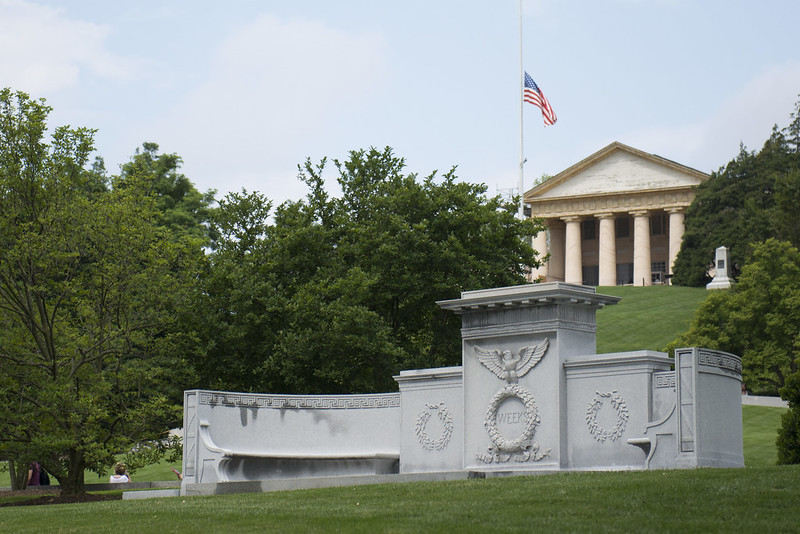
John Wingate Weeks, U.S. Navy (1860-1926) — John Wingate Weeks served in both houses of Congress and as secretary of war under two presidents. An 1881 graduate of the United States Naval Academy, he served in the Massachusetts Naval Brigade (1890-1900) and as a volunteer in the U.S. Navy during the Spanish-American War (1898). Though Weeks initially worked in civil engineering, he made his fortune in banking, as co-founder of the Boston financial firm Hornblower and Weeks. A committed Republican, in 1904 he was elected to the House of Representatives, representing Massachusetts for four terms; he subsequently won election to the Senate, where he served one term (1913-1919). In 1921, President Warren Harding appointed Weeks secretary of war, a position that he continued under President Calvin Coolidge. Reflecting his wealth, Weeks has one of the most grandiose private markers at the cemetery (pictured, above). (Section 5, Grave 7064)
Donald H. Rumsfeld, U.S. Navy (1932-2021) — Secretary of Defense Donald Rumsfeld had the distinction of being both the youngest and the oldest person to hold that position: first appointed at age 43, by President Gerald Ford (1975-1977), and then at age 74, by President George W. Bush (2001-2006). Rumsfeld attended Princeton University and joined the Naval ROTC program. He served in the U.S. Navy as an aviator and flight instructor before transferring to the Naval Ready Reserve. He continued flying as a drilling reservist until 1975. Rumsfeld began his government career in Congress, winning election to the House of Representatives (R-IL) in 1962; he was re-elected three times. He next served as Nixon’s ambassador to NATO and Ford’s chief of staff, prior to becoming secretary of defense. After Ford lost the election of 1978, Rumsfeld forged a successful career in the private sector. When he returned to government as Bush’s secretary of defense, Rumsfeld initially aimed to revamp the U.S. military to become more streamlined and adaptable for the post-Cold War era. Yet the attacks of September 11, 2001—which Rumsfeld experienced at the Pentagon—led him to preside over a new era defined by global terrorism and the wars in Afghanistan and Iraq. Although Rumsfeld came under criticism for the United States’ actions in Iraq, he expressed no regrets in his bestselling 2011 memoir, “Known and Unknown.” (Section 34, Grave 381-A)
Other Government Positions
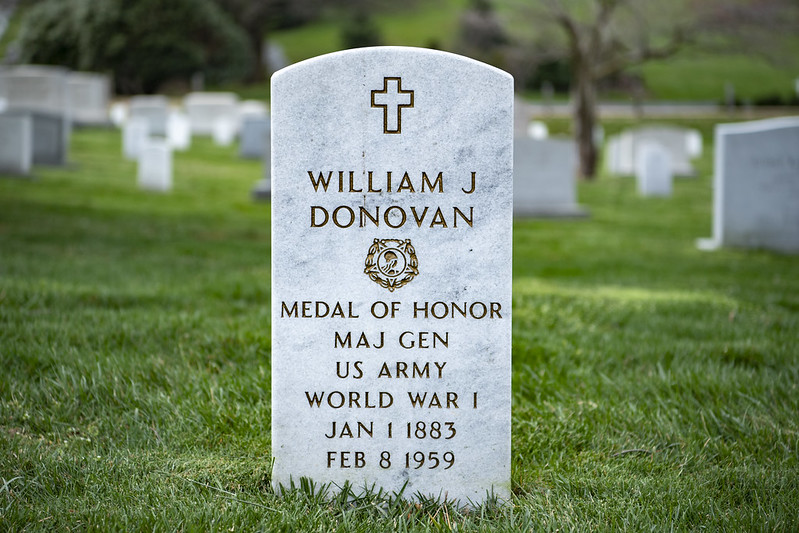
William J. Donovan, U.S. Army (1883-1959) — From 1942 to 1945, U.S. Army officer William “Wild Bill” Donovan served as the founding director of the Office of Strategic Services (OSS), predecessor of the Central Intelligence Agency. Promoted to major general in 1944, Donovan was the first person in history to earn the United States' four highest awards: the Medal of Honor, the Distinguished Service Cross, the Distinguished Service Medal and the National Security Medal. He earned the Medal of Honor for extraordinary heroism in action at Landres-et-St. Georges, France during World War I. (Section 2, Grave 4874)
Helen Hamilton Gardener (1853-1925) — In April 1920, President Woodrow Wilson appointed Helen Hamilton Gardener as one of three U.S. Civil Service Commissioners, responsible for overseeing nearly 700,000 federal employees. Gardener had previously served as a vice president of the National American Woman Suffrage Association, and she was said to have persuaded President Wilson to support the 19th amendment (which guaranteed women the right to vote). A well-connected resident of Washington, D.C., she played a key role in preserving documents and artifacts from the suffrage movement. These items remain in the collections of the Smithsonian Institution's National Museum of American History. (Section 3, Grave 4072)
William Franklin Knox, U.S. Army (1874-1944) — William Franklin "Frank" Knox, secretary of the navy from 1940 to 1944, was a journalist, publisher and politician who served in three wars. He fought with the Rough Riders in the Spanish-American War, served as an Army artillery officer in France during World War I and was secretary of the Navy during World War II. Knox began his career in journalism as a reporter for a small newspaper in Grand Rapids, Michigan, and worked his way up to becoming the publisher and part owner of the Chicago Daily News. In 1936, he ran for vice president on the Republican ticket, and in 1940, President Franklin D. Roosevelt appointed him secretary of the Navy — a position he held until his death in 1944. Knox consistently advocated national preparedness and a two-ocean Navy, and under his leadership the Navy's size and strength expanded significantly. (Section 2, Grave 4961)
William Leahy, U.S. Navy (1875-1959) — Leahy was one of two admirals promoted to fleet admiral (five-star) in December 1944. He served in the Spanish-American War and World War I, and as chief of naval operations from 1937 to 1939, he oversaw the Navy's return to preparedness during the lead-up to World War II. In a distinguished public service career, Adm. Leahy also served as governor of Puerto Rico, U.S. ambassador to France and chief of staff to Presidents Franklin D. Roosevelt and Harry Truman. (Section 2, Grave 932)
Charles Pierce, U.S. Army (1858-1921) — Pierce is considered the "Father of Mortuary Affairs." After the Spanish-American War, he headed the Office of Identification and the U.S. Army Morgue in the Philippines, where he perfected new techniques for identifying the war dead, maintaining accurate records and transferring embalmed remains back to the United States for proper burial. He retired from active duty in 1908, but was recalled to service at the outset of World War I and was named chief of the newly created Graves Registration Service. (Section 15, Grave 7)
Xenophon Price, U.S. Army (1892-1979) — As secretary of the American Battle Monuments Commission from 1923 to 1925, Price managed eight American cemeteries in Europe and oversaw the construction of war memorials. During World War I, Price had served as a military aide to President Woodrow Wilson. He also served in France with the Army's 11th Engineers Regiment, which he helped train and equip. He earned the Army Distinguished Service Medal for his contributions to Army Expeditionary Forces operations. (Section 11, Grave 416-2)
Elwood R. “Pete” Quesada, U.S. Air Force (1904-1993) — President Eisenhower appointed Lt. Gen. Pete Quesada as the first administrator of the Federal Aviation Administration (FAA) in 1959, in recognition of his many accomplishments in both military and civil aviation. In 1929, as a reserve officer in the U.S. Army Air Corps, Quesada was a crew member on the record-setting "Question Mark" endurance flight; staying aloft for more than six days, it demonstrated the feasibility of in-flight refueling. All five members of the crew, which also included legendary pilots Ira Eaker and Carl Spaatz, received the Distinguished Flying Cross. During World War II, Quesada held fighter commands during campaigns in Italy, North Africa and Europe, including the D-Day invasion in June 1944. He received two Distinguished Service Medals, the Legion of Merit and the Purple Heart. After retiring from active duty in 1951, Quesada entered private industry as an executive at Lockheed. He headed the FAA from 1959 to 1961. (Section 30, Grave 439-LH)
Walter Bedell "Beetle" Smith, U.S. Army (1895-1961) — Known affectionately as "Beetle," General Walter Bedell Smith served during World War II as General Dwight D. Eisenhower’s chief of staff, first in North Africa, Sicily and Italy, and then at the Supreme Headquarters Allied Expeditionary Force (SHAEF) in England and France. He played a key role in orchestrating Nazi Germany's surrender to the Allies on May 7, 1945. After the war, Smith held foreign policy leadership positions in the Truman and Eisenhower administrations, serving as U.S. ambassador to the Soviet Union (1946-1948), director of the Central Intelligence Agency (1950-1953) and undersecretary of state (1953-1954). (Section 7, Grave 8197-A)
James R. Tanner, U.S. Army (1844-1927) — A corporal in the 87th New York Volunteer Infantry during the Civil War, James Tanner suffered a gruesome wound at the Second Battle of Bull Run in August 1862, which resulted in the loss of both legs. After the war, this wounded warrior became a civil servant, working as a stenographer at the War Department. On April 14, 1865, as President Abraham Lincoln lay dying from an assassin's bullet, Tanner was summoned to Lincoln's deathbed to record the testimony of witnesses. Tanner was also a prominent advocate for veterans' rights. He served for a time as the U.S. commissioner of pensions and later became commander-in-chief of the Grand Army of the Republic, an organization for U.S. veterans of the Civil War. In 2014, Arlington National Cemetery renamed the newly restored "Old Amphitheater," originally built in 1873, as the James R. Tanner Amphitheater. (Section 2, Grave 877)
Civic Leaders

Medgar Evers, U.S. Army (1925–1963) — Born in Decatur, Mississippi, Sgt. Medgar Evers served in the U.S. Army during World War II, fighting with a segregated unit in France and Germany. His experiences of racial discrimination, both in and out of uniform, motivated him to become a civil rights activist. As Mississippi field secretary of the National Association for the Advancement of Colored People (NAACP), Evers recruited hundreds of members, organized voter registration drives and economic boycotts, and investigated racially based crimes, including the 1955 lynching and murder of Emmett Till. In response, white supremacists repeatedly threatened his life. On June 12, 1963, a Ku Klux Klan member shot and killed Evers in front of his home. The murder made national headlines, and thousands of mourners attended Evers' full military honors funeral at Arlington. The following year, President Lyndon B. Johnson signed the Civil Rights Act of 1964 — one victory in the struggle for which Evers sacrificed his life. (Section 36, Grave 1431)
Seraph Young Ford (1846–1938) — On February 14, 1870, Seraph Young became, according to many accounts, the first woman in the United States to vote under a women’s equal suffrage law. Two days earlier, Utah (then a U.S. territory) had passed legislation granting women the right to vote. Young, a schoolteacher and the grand-niece of Brigham Young, president of the Church of Jesus Christ of Latter-day Saints (LDS) and Utah’s first governor, became the first woman to cast a ballot when she exercised her newly-granted franchise in a Salt Lake City local election. A few months later in August 1870 during Utah’s general election, approximately 2,000 women voted. In 1872, two years after she voted for the first time, Seraph Young married Seth L. Ford, who had fought for the U.S. Army during the Civil War. He is buried alongside his wife, a pioneering figure in American history in her own right. (Section 13, Grave 89-A)
Jacqueline Bouvier Kennedy Onassis (1929–1994) — Although John F. Kennedy's presidency (1961-1963) was cut short by an assassin's bullet, Jacqueline Bouvier Kennedy Onassis became an enduring cultural icon. Born to an elite New York family, she worked as a photojournalist before marrying Kennedy, then a senator from Massachusetts, in 1953. Over 700 guests attended their Newport, Rhode Island wedding, considered the social event of the season. As First Lady, her unflappable poise and impeccable sense of style helped foster the glamorous, "Camelot" image of the Kennedy presidency. Mrs. Kennedy also undertook a major restoration of the White House and earned acclaim on her many foreign trips as an emissary of the United States. After JFK's assassination on November 22, 1963, she played a key role in planning her husband's state funeral and selecting Arlington National Cemetery for his gravesite. In 1968, she married Greek shipping magnate Aristotle Onassis, a longtime friend. Kennedy Onassis died from cancer on May 19, 1994 and was interred next to John F. Kennedy a few days later. President Bill Clinton delivered her eulogy. (Section 45)
Helen Herron “Nellie” Taft (1861–1943) — Helen Taft, who went by the nickname "Nellie," was the wife of President William Howard Taft and first lady of the United States from 1909 to 1913. Raised in a prominent Ohio political family, she visited the White House as a teenager and vowed that she would one day live there. As first lady, Taft took a keen interest in current events and reportedly had as much influence on her husband as a cabinet member. She implemented safety and sanitary standards for federal workplaces, opened the White House to a wider range of visitors and became the first first lady to ride in the inaugural parade. Nellie Taft's most visible legacies are the more than 3,000 cherry trees that grace Washington, D.C.'s Tidal Basin; she personally planted the first saplings in March 1912. After President Taft died in 1930, she commissioned noted sculptor James Earle Fraser to design the monument for his gravesite, where she too was buried in 1943. (Section 30, Grave S-14)
Zitkála-Ša (Gertrude Simmons Bonnin) (1876–1938) — A member of the Yankton Dakota Sioux, Zitkála-Ša was born on the Yankton Reservation in South Dakota in 1876. At an Indian boarding school, she was given a European name, Gertrude Simmons. As an adult, she returned to the Yankton Reservation and began collecting and publishing traditional Dakota stories. While working as a clerk for the Bureau of Indian Affairs, she met and married U.S. Army Captain Raymond Talefase Bonnin, who was also of Dakota descent. In 1910, Zitkála-Ša wrote the libretto for "The Sun Dance Opera,” based on a sacred Sioux ritual. She also frequently wrote about American Indian issues for high-profile national magazines and advocated for legislative reforms. In 1925, the Bonnins purchased a home in Arlington’s Lyon Park neighborhood — where a park was dedicated in her name in 2021. In 2024, the U.S. Mint honored her historical contributions by placing her likeness on a quarter, as part of the American Women Quarters series. (Section 2, Grave 4703)
See also: